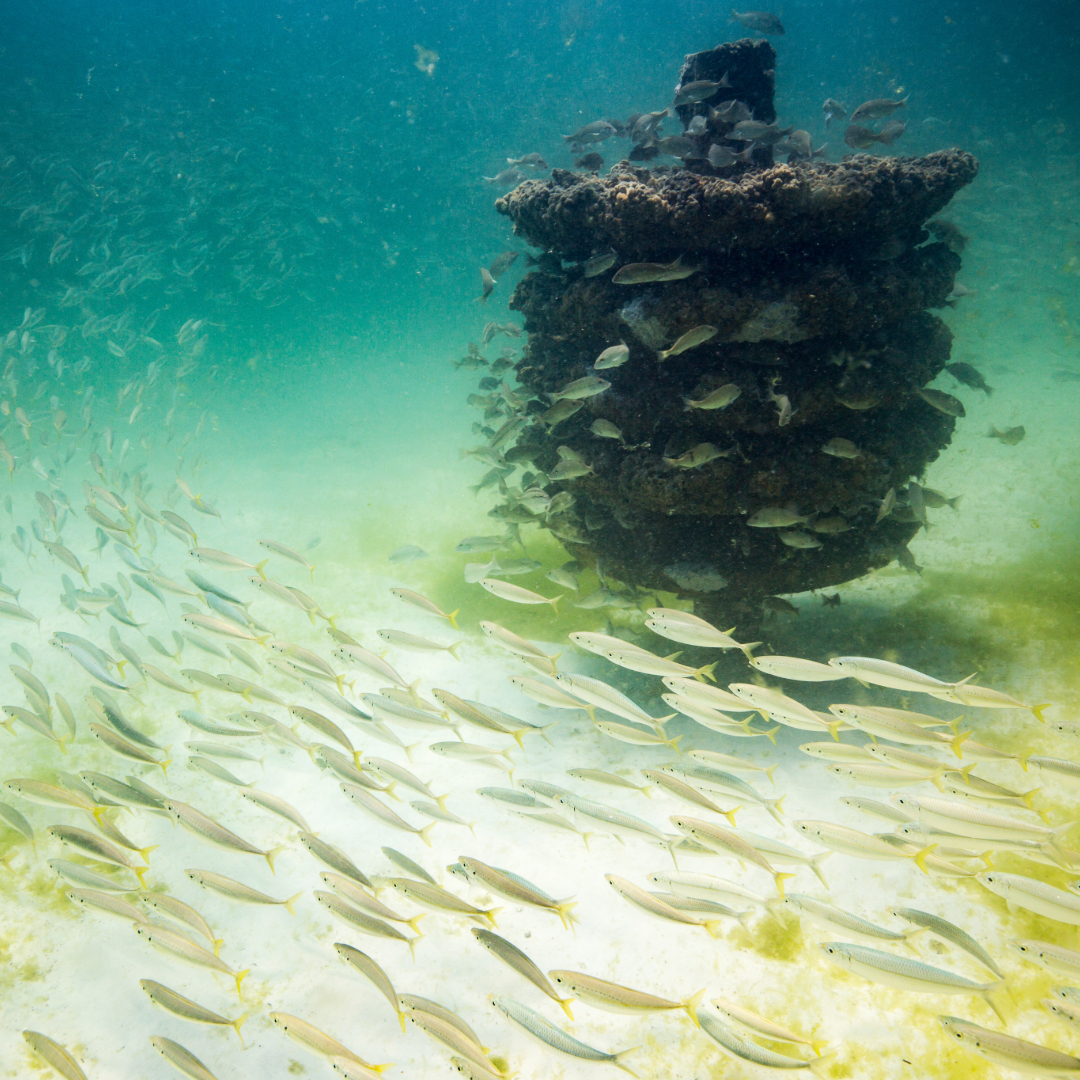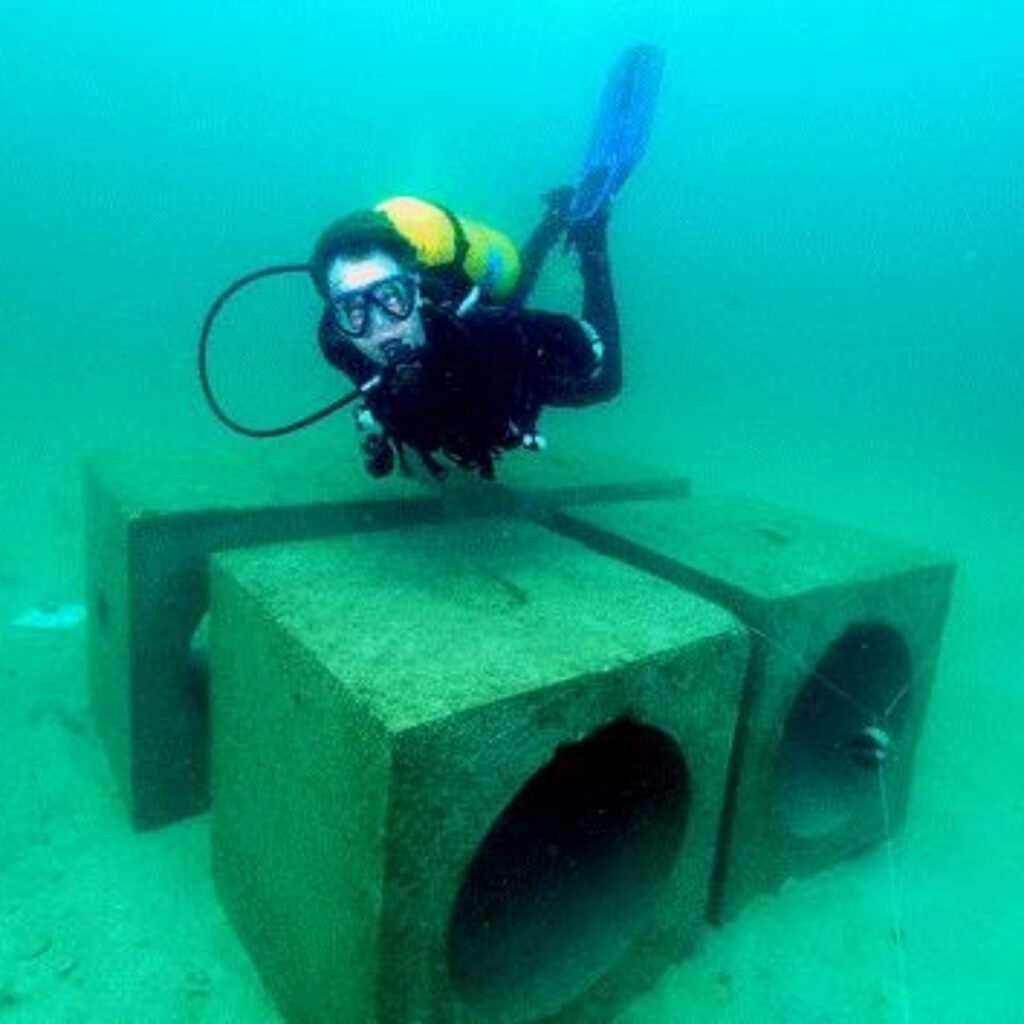
Artificial reef in Walton County, 2017. Image by Bernard Brzezinski, University of Florida.
Florida Sea Grant’s Artificial Reef Legacy is a 3-part series that explores the rich history of artificial reefs in Florida and highlights Florida Sea Grant’s longstanding support through science, monitoring, outreach, and education. In this installment, Dr. Bill Lindberg shares some of the early beginnings of Florida Sea Grant’s artificial reef effort.
Submerge into the depths of Florida’s Gulf Coast, and you might uncover sunken ships, antiquated bridge structures, and formations resembling pyramids and spheres with Swiss-cheese-like holes. While they might seem out of place and even otherworldly, these structures terraform vibrant landscapes, colonized by barnacles, algae, and coral. Known as artificial reefs, these man made underwater structures have been used for over a century to provide marine habitats.
Don’t let the word ‘artificial’ fool you. Though it suggests something modern or even futuristic, the practice of creating artificial reefs actually dates back to the 1950s and ’60s. During this time, local fishermen began placing ‘materials of opportunity’ like railroad cars, buses, and appliances to attract marine life. While some deteriorated quickly, today’s artificial reefs are carefully selected for durability and environmental safety.
“They mimic some of the natural things that we find, like a Northwest Florida limestone, but as you go further south, some of the coral reefs, those will be some good things that we’re trying to mimic,” says Scott Jackson, Florida Sea Grant UF/IFAS Regional Specialized Extension Agent in Bay County.
Strategically placed, artificial reefs help reduce fishing and diving pressure on sensitive natural habitats, protect coastlines from storm damage, and ease overcrowding at popular natural reefs, especially in Florida’s recreational diving areas.
Florida has one of the most active artificial reef programs in the U.S. Since the 1940s, more than 4,300 public artificial reefs have been placed in state and federal waters off Florida’s coast.
Artificial reefs are often considered important for tourism-based economies.
- On average, 48% of anglers utilize Florida’s artificial reefs, generating $3.1 billion in annual economic activity.
- Artificial reefs generate 39,118 jobs and $4.4 billion in economic output and income for Floridians.
- For every $1 spent on artificial reefs in the Florida Panhandle, the economic benefit of artificial reef expenditures returns $138.
Thanks to decades of Florida Sea Grant involvement with Florida Fish and Wildlife Conservation (FWC), the state’s artificial reef program has evolved, using the best available science to guide reef creation and monitoring. As of 2019, Florida Sea Grant has been integral in the permitting, deployment, and monitoring of 25 new artificial reefs intended to support recreational fishing. This project added $25.8 million to the state’s economy and supported 325 jobs.
“The oceanography, fisheries, and seascapes around our coastline vary so broadly that a one-size-fits-all approach to artificial reefs just doesn’t work,” says Dr. William “Bill” Lindberg. “Florida Sea Grant’s research on artificial reef structures, fish behavior, economic impacts, and citizen science opportunities is so crucial—it ensures these artificial reefs meet local needs.”
Providing essential ecosystem and marine habitat functions, Florida Sea Grant artificial reef program has supported scientific research and monitoring efforts aimed at maximizing the design, placement, and conservation and angling functions of artificial reefs.
Beginning in the early 1990s, Dr. Bill Lindberg and his team used artificial reefs as a natural ocean laboratory, monitoring gag grouper life history stages and the impact of reef habitats on grouper populations, data important for fisheries management.
The oceanography, fisheries, and seascapes around our coastline vary so broadly that a one-size-fits-all approach to artificial reefs just doesn’t work.
Dr. Bill Lindberg

Dr. Bill Lindburg leads research on artificial research done underwater by highly trained scientific divers.
Lindberg’s team constructed the Steinhatchee Fisheries Management Area (SFMA), a series of specially designed “conservation reefs” located in the Big Bend region of Florida. These sites were part of fisheries-independent monitoring efforts to aid gag stock assessments and evaluate the effectiveness of “conservation” reefs built in a 100-square-mile triangle located about 18 miles west of Steinhatchee, Florida. Lindberg’s study and deployed reefs represented a new approach to Florida’s artificial reef program.
“In the past, the primary goal of artificial reefs was to enhance fishing success. While that’s still a key objective, the Artificial Reef Strategic Plan adopted by the state in 2003 also includes an explicit goal of using artificial reefs as a component of ecosystem management,” says Dr. Lindberg.
The specially designed concrete blocks used by Lindberg’s team—now known as Lindberg cubes—feature holes and crevices between cubes where groupers can take shelter, offering protection from predators.
The project reached a significant milestone with the deployment of 500 artificial reef patches strategically placed across the Big Bend. However, this study has also raised a long-debated question:
Do artificial reefs actually increase fish populations, or do they simply increase the number of fish being caught?
“Researchers struggled with this question for decades producing seemingly conflicting results. Today’s consensus is that the answer to the question is both yes and no – it depends,” says Jackson. “When fishing pressure and mortality exceed the number of fish produced, artificial reefs can end up as expensive fishing equipment. It’s in everyone’s interest to avoid this situation and create productive resources.”
In 2022, a Florida Sea Grant team coauthored a blog series on artificial reefs including topics of how they are implemented, the ecological effects of artificial reefs on fish, effects on fishers and divers, and fisheries. These long-lasting habitat alterations have measurable effects overall marine ecosystem and connected human socioeconomic system, so it is critical to understand how artificial reefs “work” to make good decisions about future artificial reefs.
With new and evolving questions surrounding artificial reefs and data gaps, Florida Sea Grant’s monitoring program provides essential data and observations to assess whether the reef sites are suitable, the structures are in proper condition, the fish populations are thriving, and much more. Stay tuned for Part 2 of this series to learn more about Florida Sea Grant’s monitoring efforts and how artificial reefs play a role in preserving local culture.